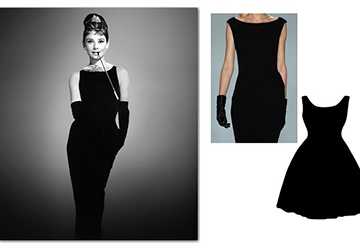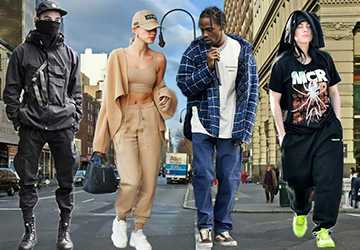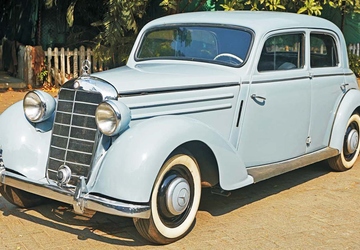Fashion has always been more than just clothes; it reflects society, culture, and individual expression. Over the years, moments in fashion have defined eras and shaped how we perceive style. Let's walk down memory lane and revisit iconic fashion moments that left an indelible mark on history.
1. The Little Black Dress by Coco Chanel (1920s)
In the 1920s, Coco Chanel introduced the "Little Black Dress" (LBD). Before this, black was primarily associated with mourning or sad occasions. Chanel's revolutionary idea was to transform black into a symbol of elegance, simplicity, and versatility.

The LBD became a staple in every woman's wardrobe, transcending socio-economic boundaries and redefining evening wear. Its timeless appeal continues to influence designers and remains a go-to choice for countless women, proving that sometimes less truly is more.
2. The New Look by Christian Dior (1947)
After the austerity of World War II, fashion was ripe for a change. Enter Christian Dior with his groundbreaking "New Look" in 1947. Dior's collection reintroduced a sense of luxury and femininity with its cinched waists, full skirts, and hourglass silhouettes.
The New Look was a stark departure from the boxy, utilitarian styles of the war years. While it faced some criticism for being extravagant, its profound impact on post-war fashion is not denied. Dior's designs heralded a return to glamour and set the stage for the following fashion-forward decades.
3. Yves Saint Laurent's Le Smoking (1966)
In the swinging sixties, Yves Saint Laurent shattered gender norms with his iconic tuxedo suit for women, famously known as "Le Smoking." The ensemble featured a tailored jacket and trousers, exuding an air of sophisticated androgyny. Le Smoking was bold, challenging traditional notions of femininity and offering women an empowered, alternative eveningwear option.
It became a symbol of rebellion and remains a testament to Saint Laurent's innovative spirit. Le Smoking changed the fashion landscape and paved the way for greater gender inclusivity in design.
4. The Punk Revolution (1970s)
The 1970s witnessed the rise of punk culture, and with it came a radical shift in fashion. Punk style was all about DIY attitude, anti-establishment ethos, and a distinct aesthetic characterized by ripped clothing, safety pins, and bold graphics.
Designers like Vivienne Westwood and Malcolm McLaren played pivotal roles in popularizing punk fashion, transforming it from a subcultural movement to a global phenomenon. The punk revolution challenged fashion conventions, emphasizing individualism and self-expression. Its raw energy and rebellious spirit inspire designers and fashion enthusiasts alike.
5. Lady Diana's Revenge Dress (1994)
A list of iconic fashion moments would only be complete with mentioning Lady Diana, Princess of Wales. In 1994, on the same evening Prince Charles confessed to his affair with Camilla Parker Bowles on national television, Lady Diana made a stunning appearance at the Serpentine Gallery's summer party in a figure-hugging black dress by Christina Stambolian.
Dubbed the "Revenge Dress," this ensemble was more than just a fashion statement; it was a powerful message of resilience and defiance. Lady Diana's choice to wear the dress on that particular night captured the world's attention, solidifying her status as a style icon and symbolizing the triumph of grace under pressure.
6. Marilyn Monroe's White Dress Moment (1955)
In 1955, Marilyn Monroe solidified her status as a style icon with a single scene in the film "The Seven Year Itch." The image of Monroe standing over a subway grate, her white halter dress billowing around her, is etched in the annals of fashion history.
Designed by William Travilla, this iconic white dress became synonymous with Monroe's sensuality and epitomized the allure of the classic Hollywood era. Its timeless elegance inspires designers and remains a quintessential symbol of glamour.
7. The Birth of the Miniskirt (1960s)
The 1960s ushered in a sartorial revolution with the introduction of the miniskirt. British designer Mary Quant is often credited with popularizing this daring and liberating style. The miniskirt represented more than just a shorter hemline; it symbolized youthfulness, freedom, and the spirit of the swinging sixties.
Its impact was revolutionary, challenging societal norms and sparking debates about femininity and propriety. The miniskirt remains a staple in fashion, continuously reinvented and celebrated for its audacious charm.
8. The Grunge Movement (1990s)
The 1990s witnessed the rise of grunge fashion, a counter-cultural movement that rejected the polished aesthetics of the previous decade. Inspired by the music scene in Seattle, grunge style embraced an anti-fashion ethos characterized by flannel shirts, distressed denim, and combat boots.
Designers like Marc Jacobs for Perry Ellis incorporated grunge elements into high fashion collections, blurring the lines between streetwear and couture. The grunge movement was a testament to the power of authenticity and individualism, leaving an indelible mark on 1990s fashion.
9. The Rise of Streetwear (2000s)
The 2000s marked the ascent of streetwear as a dominant force in the fashion industry. From urban youth culture, streetwear transcended its niche origins to become a global phenomenon. Brands like Supreme, BAPE, and Off-White pioneered the fusion of high fashion and street style, creating coveted collections that blurred traditional boundaries.

Collaborations between luxury labels and streetwear brands became highly anticipated events, reflecting a shift in consumer preferences and the growing influence of street culture on mainstream fashion.
10. The Sustainability Movement (2010s)
The fashion industry has recently witnessed a growing emphasis on sustainability and ethical practices. The 2010s marked a pivotal moment with the rise of eco-conscious brands and initiatives aimed at reducing the environmental impact of fashion.
Designers and consumers alike began to prioritize transparency, ethical production methods, and responsible consumption. The sustainability movement has challenged the industry to rethink its practices and embrace a more holistic approach to fashion, emphasizing longevity, craftsmanship, and social responsibility.
Conclusion
These five iconic fashion moments have shaped the industry and reflected societal shifts and cultural movements. From Coco Chanel's timeless elegance to Lady Diana's indomitable spirit, each moment encapsulates the essence of its era while leaving an enduring legacy. As we continue to evolve in our understanding and appreciation of fashion, these milestones serve as poignant reminders of its transformative power.





